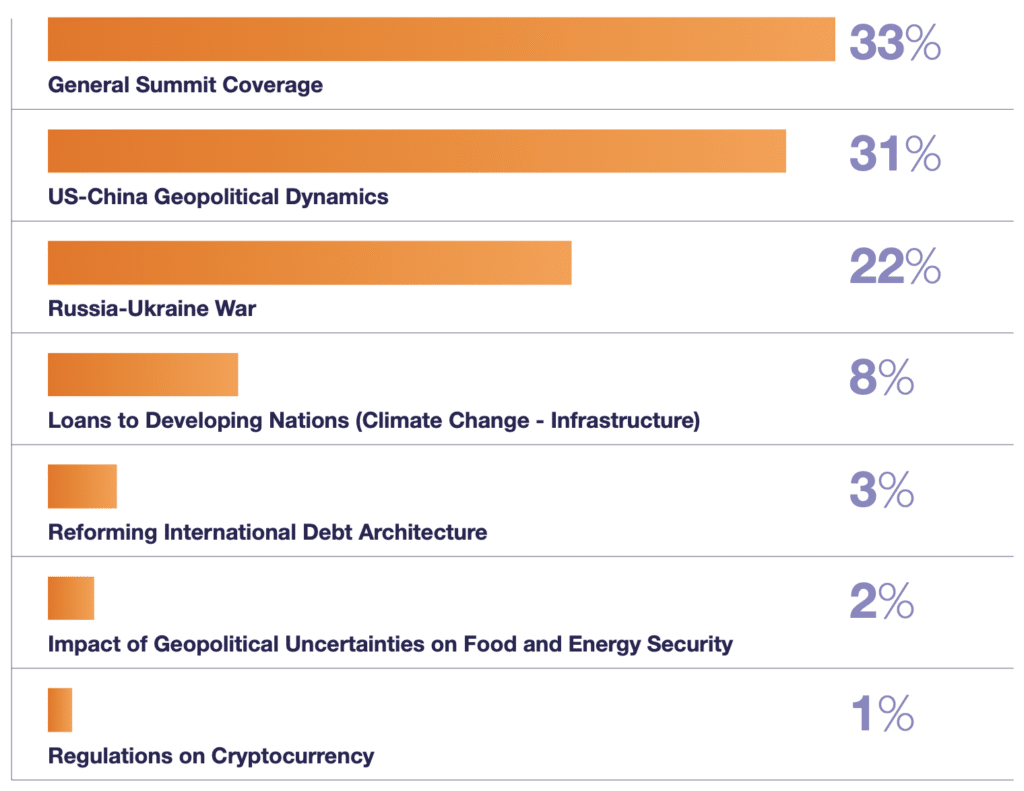The 2023 G20 summit captured substantial media attention, reflecting its international significance, and evolving global political dynamics. Our analysis delves into the dominant narratives that emerged across media outlets, shedding light on topics that were most frequently published on traditional media.
To gain a comprehensive perspective on the 2023 G20 event, we invite you to access our free media overview.
Leading Coverage Drivers
Coverage drivers on traditional media broken down by share of voice (SOV)

Our analysis of the 2023 G20 Summit coverage uncovered multiple recurring themes:
- General Summit Coverage (33% of Coverage): India, during its G20 presidency, emphasized global unity under the theme “One Earth, One Family, One Future.” Hosting the summit in New Delhi, PM Modi showcased India’s heritage and sought increased inclusivity by inviting the African Union. India’s leadership centered on reinforcing global cooperation and multilateralism.
- US-China Geopolitical Dynamics (31% of Coverage): The G20 summit saw an undercurrent of US-China tensions. With China’s president absent, the US advanced proposals on debt relief and climate change, aiming to assert its global influence. In contrast, China focused on its economic initiatives and BRICS alliances, revealing the continued geopolitical rivalry.
- Russia-Ukraine War (22% of Coverage): The Russia-Ukraine conflict was a focal point, but the G20’s official statement avoided directly naming Russia as the aggressor. Instead, it highlighted the principles of sovereignty and territorial integrity, calling for an end to military aggression, reflecting the summit’s delicate geopolitical balance.
- Loans to Developing Nations (8% of Coverage): Addressing climate finance, the G20 highlighted developed countries’ role in rallying resources for the developing world. Outlets such as Reuters and News 18 spotlight the intensified need for substantial investment in climate actions and sustainable infrastructure, with initiatives like the India-Middle East-Europe Economic Corridor signifying this global recognition.
Additional themes such as the restructuring of international debt mechanisms, the influence of geopolitical instabilities on food and energy security, and discussions on cryptocurrency regulations were also prevalent in the media narrative, albeit with a smaller share.
Share of Voice (SOV) on Traditional Media
Diving into the geographical dispersion of these narratives, media outlets from the United States took the forefront with a 33% SOV, succeeded by India at 29%, the United Kingdom at 16%, Italy at 11%, and Australia at 9%. The media from these countries played a pivotal role in shaping the global conversation about the summit. In the following section, we will delve into the standout stories from media outlets of the top three countries and examine the factors driving the dominant themes.
Top Stories and Their Impact
Highlighted stories from major media outlets present varied perspectives on the summit events, from US media’s focus on geopolitical complexities to the Indian media’s emphasis on the presidency’s pivotal role and the UK media’s spotlight on the US-China dynamics. The following were the coverages top stories:
G20’s Ukraine Stance Shifts – US Media
The U.S. media delved deeply into geopolitical complexities and diplomatic maneuvers, with 43% of their stories centering on the Russia-Ukraine conflict. ABC News highlighted the notable shift in the G20’s stance on Ukraine, emphasizing the avoidance of direct mentions of Russia’s invasion. Echoing similar sentiments, The Washington Post highlighted the US’s efforts in achieving a consensus document, a move seen as ensuring G20 unity while preventing a potential geopolitical advantage for China, while The Washington Times cast a spotlight on the Biden administration’s defence of the summit’s stance on Ukraine, providing a window into the intricate dance of global diplomacy.
India’s Leadership at the G20 Summit – Indian Media
Indian outlets prominently highlighted India’s leadership, dedicating 46% of their coverage to the broader summit themes, encompassing accolades and leadership narratives. The Economic Times (IN) underlined the financial challenges of meeting the Paris Agreement’s goals, emphasizing the responsibility shouldered by major economies. A picture of inclusive diplomacy was portrayed by Business Insider (IN), spotlighting India’s PM Modi’s emphasis on global unity and the inclusion of the African Union as a testament to this drive. Adding another layer, Times of India presented French President Macron’s commendation of India’s efforts, underscoring the nation’s significant role in fostering global unity and peace amidst turbulent times.
US-China Rivalry Dominates G20 – UK Media
The UK media spotlighted the rivalry between the US and China, amidst global divides and political absences echoing the UK outlets most covered theme, the US-China Geopolitical Dynamics (51%). The Guardian presented India’s increasing influence on the international stage, contrasting it with Xi Jinping’s notable absence and the US’ strategic initiatives to fill the geopolitical void. The G20’s challenge of achieving a unified stance was Sky News’ focus particularly concerning the Ukraine conflict and the intricacies posed by the absence of presidents Xi Jinping and Vladimir Putin. Meanwhile, The Independent (UK) reflected on the glaring omission of the traditional “family photo”, interpreting it as a symbol of ongoing rifts and divisions within the global landscape.
Final Thoughts
The narrative from the 2023 G20 summit offers insights into a world navigating geopolitical complexities, evolving alliances, and the rising prominence of emerging economies. As the landscape continues to evolve, media powerhouses like the US, India, and the UK continue to mold global viewpoints.
A Note on Methodology:
CARMA’s analysis leveraged 49,831 articles published between September 9 and September 11, 2023. This study relies on the utilization of CARMA’s technology and third-party data, which are collected through automated means.

